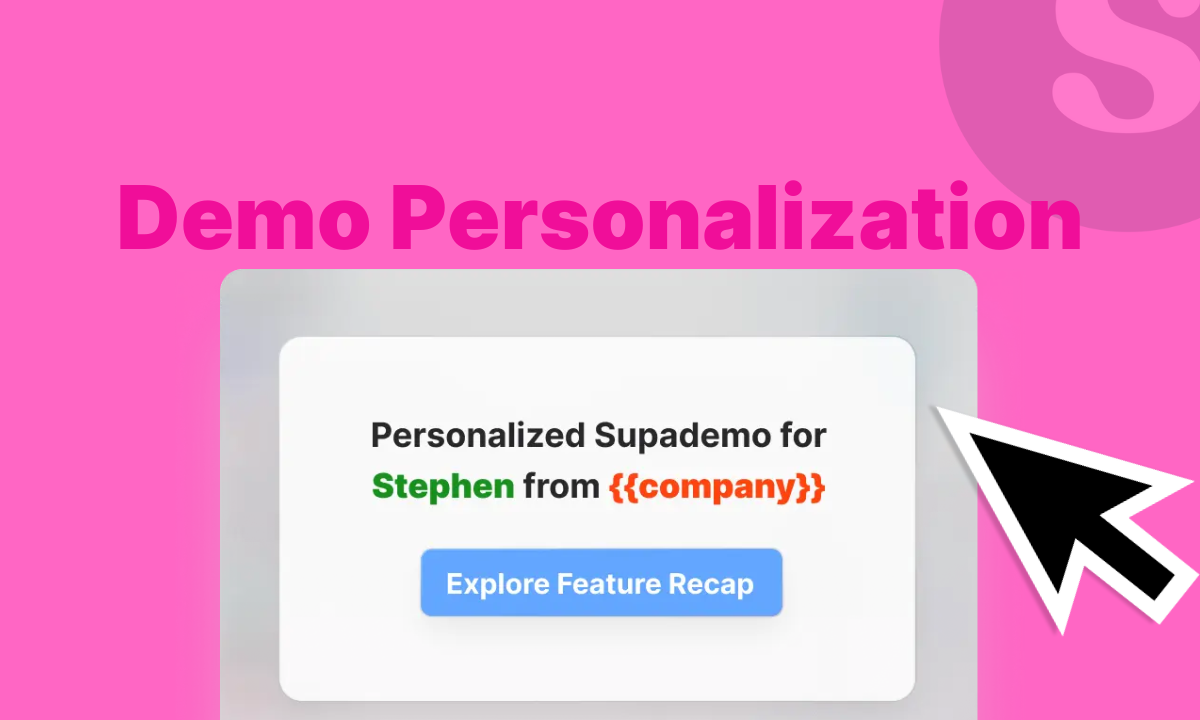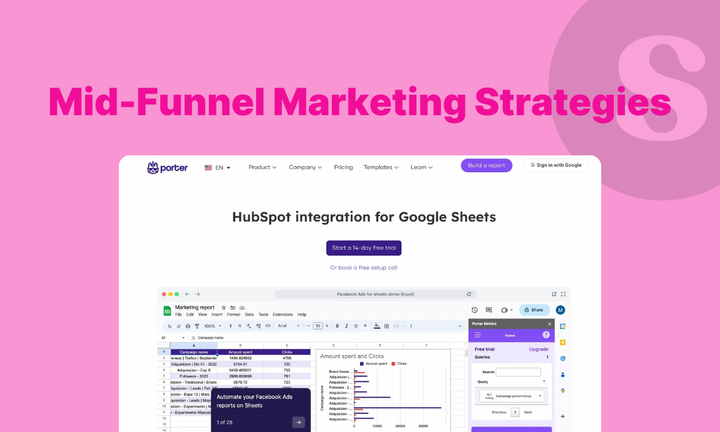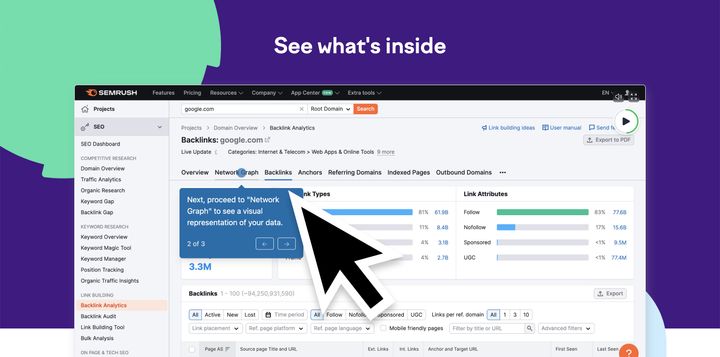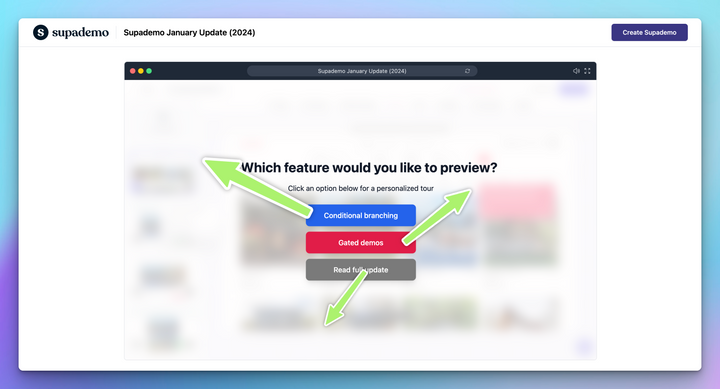Congratulations - you've got your lead's attention. Now what?
In B2B, prospects don't convert overnight. When buyers move past awareness, they start exploring different solutions, and your job is to make them consider you seriously.
This is where mid-funnel marketing tactics prove you're worth their time, budget, and trust. Skip this stage, and competitors will steal deals you could have won.
The right approach with middle-funnel marketing shifts your brand from "just another vendor" to the obvious choice. In this guide, you'll learn practical ways to engage, educate, and convert prospects who are actively evaluating options.
What is mid-funnel marketing?
Mid-funnel marketing targets prospects who know they have a problem, are actively evaluating solutions, but haven't decided on a vendor yet. These buyers are informed, skeptical, and comparing multiple options.
These buyers don’t need surface-level content—they need proof. Case studies, interactive demos, and thought leadership show them how your product solves real problems and give them confidence to put you on their shortlist.
Your goal: become their obvious choice by providing educational content and proof that you solve their specific problems better than anyone else.
Understanding TOFU vs MOFU vs BOFU
To really understand where the middle of the funnel fits, it helps to step back and see the bigger picture. Every buyer journey runs through three main stages: top, middle, and bottom of the funnel.
Each stage has a different buyer mindset and calls for a different marketing approach. Let’s break them down.
| Funnel Stage | What it Means | Goal | Buyer Mindset | Nature of Strategy | Content That Works |
|---|---|---|---|---|---|
| TOFU (Top of Funnel) | Awareness stage where prospects first discover your brand. | Build awareness and attract interest. | “I know something isn’t working, but I’m still figuring out the problem and possible solutions.” | Inform, don’t sell. Focus on education and soft nudges that help prospects define their problem. | Blogs, SEO-driven guides, social posts, explainer videos, educational resources. |
| MOFU (Middle of Funnel) | Consideration stage where prospects compare solutions. | Build trust and prove value. | “I understand my problem and I’m evaluating which solutions can solve it best.” | Educate and position. Show how you solve problems better than others without pushing for a close. | Case studies, interactive product tours, webinars, industry reports, nurture emails. |
| BOFU (Bottom of Funnel) | Decision stage where prospects are ready to buy. | Drive conversions and reduce risk. | “I’ve shortlisted vendors and need proof that your solution is the safest, smartest choice.” | Be specific and persuasive. Show ROI, reduce risk, and make it easy to say yes. | Free trials, ROI calculators, tailored demos, product comparisons, pricing pages. |
Why is middle-of-the-funnel marketing important for B2B SaaS?
Here's the reality: B2B purchases take 6-18 months and involve 6-10 decision makers. In that time, priorities shift and vendors start to look alike. Without strong mid-funnel marketing, you fade from view before decisions are made.
Strong mid-funnel programs accomplish three things:
- Keep you top of mind when deals take months to close. A well-timed case study or product tour can bring you back into the conversation when momentum starts to fade.
- Build credibility with multiple stakeholders. Even if your champion loves your solution, they need proof to persuade finance, IT, or leadership. MOFU content arms them with the right arguments.
- Differentiate your solution from competitors. At this stage, buyers often see vendors as interchangeable. Evidence-driven marketing—whether that’s customer results, interactive demos, or research—sets you apart.
For SaaS companies with long, complex sales cycles, mid-funnel marketing isn’t optional. It’s what keeps you relevant, credible, and in the running when the deal is finally on the table.
8 High-impact mid-funnel marketing strategies to win more deals
Theory only gets you so far. To win in the middle of the funnel, you need tactics that speak to how buyers actually evaluate and compare solutions.
These 8 strategies, backed by real examples, will help you prove value, earn trust, and separate yourself from competitors.
Interactive product tours
52 % of B2B buyers now prefer a self-service approach to gathering information and making initial purchase decisions. To meet these expectations, interactive product tours are one of the most effective strategies that you can use.They give your buyers a hands-on way to see your product without filling out a form or booking a call.
Interactive demos work well in both product-led and sales-led motions:
- For product-led companies, tours shorten time-to-value by showing prospects exactly how the product solves key use cases.
- For sales-led companies, they qualify leads before the first call, so reps spend time with buyers who already understand the product’s value.
Take Porter Metrics, a marketing analytics platform, as an example. They added Supademo tours across landing pages, guides, and support docs. The results: a 25% lift in website engagement, faster content production, and stronger feature adoption.

Influencer marketing
In B2B SaaS, the real influence comes from practitioners, analysts, and niche experts your prospects already follow.
These voices carry weight because they educate their audiences, share real-world use cases, and show ROI in a way that feels authentic. When they vouch for your product or demonstrate it in context, it builds credibility you cannot replicate with ads or sales decks.
How to make it work:
- Pick the right people: Look for experts your ICP already trusts, not just large followings.
- Show up where buyers learn: LinkedIn, podcasts, and industry newsletters tend to hit hardest.
- Co-create useful content: Tutorials, case studies, or workflow walkthroughs work better than generic shoutouts.
- Give them access: Let influencers try your product, data, or beta features so reviews feel real.
- Invest long-term. Research shows 82% of companies with an “always-on” approach succeed, compared to 39% running one-off campaigns.
Customer testimonials and case studies
When buyers are comparing vendors, nothing carries more weight than hearing from other customers.
The goal is to show prospects that companies like theirs trust you, and back it up with results.
How to make it work:
- Sprinkle testimonials on high-intent pages like pricing, features, and compliance. This builds confidence where objections usually surface.
- Create detailed case studies that follow the “problem → solution → results” format, then repurpose them across channels including blogs, LinkedIn, nurture emails, and webinar slides.
- Leverage third-party review platforms like G2 or Capterra, which act as independent sources buyers trust more than vendor websites. Strong ratings, responses to reviews, and visible badges instantly build credibility.
Thought leadership content
When buyers reach the consideration stage, they are not only comparing features. They also want to know whether your team understands the market and can be trusted as a long-term partner. Strong thought leadership demonstrates the quality of your thinking and the expertise of your people.
LinkedIn research shows just how influential this can be:
| Buyer Behavior | Why It Matters for You |
|---|---|
| 73% of B2B buyers consider thought leadership a more trustworthy basis for judging a company’s competencies than traditional marketing materials. | Good content builds more credibility than ads or feature sheets, and directly influences how buyers rank vendors. |
| 54% of buyers say that organisations consistently producing high-quality thought leadership have prompted them to research their offers and capabilities. | Thought leadership creates inbound demand by sparking buyer curiosity and driving them deeper into your funnel. |
| 86% of buyers say they would be moderately or very likely to invite such companies to participate in a tender process. | Consistency gets you into more deal cycles and RFPs, increasing your odds of being shortlisted. |
| 60% of decision makers say they are willing to pay a premium to organisations that demonstrate the quality of their thinking and talent. | Strong thought leadership improves pricing power, reduces discount pressure, and positions you as a premium solution. |
These numbers highlight a simple truth: good thought leadership doesn’t just build awareness, it drives buying decisions. It gets you into more conversations, improves win rates, and even strengthens pricing power.
How to put it into practice:
- Publish articles or posts: Focus on customer challenges or industry shifts, using data or real examples. End with clear takeaways that prospects can apply immediately.
- Podcasts and videos: Collaborate with niche creators, or launch your own to feature industry experts, customers, and internal leaders. Keep episodes short and repurpose clips across LinkedIn, blogs, and newsletters.
- Social platforms: Share timely insights, workflows, or data-backed commentary that help buyers learn something new. Engage directly in comments and industry conversations to build trust.
Email campaigns
Email is still one of the most reliable ways to nurture prospects through the middle of the funnel. Buyers may browse your site once and never return, but a well-timed email puts your solution back in front of them when they’re comparing options.
The key is relevance. Mid-funnel prospects don’t need broad awareness emails—they need tailored proof points, practical guidance, and reminders of value.
How to make it work:
- Segment your list: Group by role, industry, or funnel stage. A finance leader cares about ROI, while a product manager wants usability. Tailor content to what each persona values most.
- Send proof, not pitches: Share short case studies or success stories with clear metrics. A headline like “How X cut reporting time by 40%” does more than a feature list ever will.
- Automate smart follow-ups: Trigger sequences when prospects download a guide, sign up for a webinar, or revisit your pricing page. Timely, behavior-based outreach keeps you relevant without spamming.
- Show, don’t tell: Embed an interactive demo or video walkthrough directly in your email. Let buyers see how your product works before they ever book a call.
For example, Senja, a testimonial platform, struggled with long outbound emails that overexplained integrations. They switched to shorter notes with a Supademo link showing the integration in action. The shift made their outreach clearer, gave prospects instant context, and led to faster responses from potential partners.
Conduct webinars
Webinars are one of the most effective ways to engage mid-funnel buyers because they combine education with interaction. Unlike blogs or emails, a webinar lets prospects see your expertise live, ask questions, and hear how other customers use your product.
But the key is positioning. A mid-funnel webinar should not be a feature walkthrough disguised as an event. It should solve a problem your ICP cares about, while naturally showing how your solution fits into that picture.
How to make it work:
- Pick buyer-driven topics: Frame webinars around challenges, not products. For example, “How SaaS finance teams cut month-end close by 30%” works better than “Demo of our reporting tool.”
- Mix speakers: Pair your internal experts with a customer or external voice. Hearing peers talk about results carries more weight than hearing your sales team pitch.
- Engage live: Use polls, chat, and Q&A to gather insights from prospects and make the session feel collaborative.
- Repurpose content: Slice recordings into short clips for LinkedIn, embed highlights in nurture emails, or turn transcripts into blog posts. Webinars should fuel your content pipeline long after the live event.
Tools like Supademo let you pre-record workflows and embed them into your webinar. That way, you can switch seamlessly between live content and guaranteed-smooth product walkthroughs, keeping the session professional and stress-free.
Industry reports and whitepapers
In the middle of the funnel, buyers are building internal cases for change. They need credible data, expert opinions, and content they can share with decision makers. Industry reports and whitepapers provide that depth. They position your company as a trusted authority while giving prospects material they can use to persuade their teams.
How to make it work:
- Anchor on data: Base your report on original research, customer benchmarks, or curated industry stats. Numbers make your case harder to ignore.
- Keep it problem-focused: Frame the report around the challenges your ICP faces, not just your product’s benefits. Buyers should see themselves in the findings.
- Design for shareability: Use charts, summaries, and pull quotes so prospects can lift key insights into decks or emails.
- Gate smartly: Consider gating the download to capture leads, but don’t hide the executive summary. Buyers often want a preview before committing.
- Repurpose widely: Break the report into blogs, infographics, LinkedIn posts, and webinar topics to extend its shelf life.
Focus on value-driven sales conversations
When prospects meet your sales team mid-funnel, the conversation must go beyond a scripted demo. Buyers want proof that your solution fits their needs and that you understand their challenges.
This is where a consultative approach matters:
- Start with discovery instead of leading with features.
- Ask about broken workflows to uncover where value is missing.
- Identify the KPIs that drive their decision-making.
- Surface the risks they need to avoid when evaluating solutions.
- Use these insights to build trust and confirm whether you’re the right fit.
The challenge? Reps often spend hours building custom demos, leaving little time to prepare for meaningful conversations. That’s where demo automation helps.
Easy Software, one of Germany’s leading SaaS providers, struggled with a manual, high-effort demo creation process that slowed deals and drained resources. They adopted Supademo, an AI-powered demo automation platform, to capture reusable product tours that could be shared across the customer journey.
"We not only created lots of Supademos for different use cases, but our AEs just closed their first deals using just Supademo."
~ Felix True, Head of Presales
The impact:
- Prospects reached the “aha” moment faster
- Shorter sales cycles
- Multiple six-figure ARR deals closed with async Supademos
- 5+ hours saved per week through demo automation

Bringing mid-funnel marketing best practices together
Winning in the middle of the funnel comes down to one principle: give buyers proof, not pitches. Case studies, thought leadership, reviews, webinars, and reports all work because they educate prospects, build trust, and give internal champions the material they need to advocate for you.
The most effective strategies share three best practices:
- Be buyer-centric: Focus on their problems, KPIs, and risks.
- Show, don’t tell: Use demos, data, and real customer outcomes instead of promises.
- Think shareability: Create assets prospects can forward to decision makers.
Among all these tactics, interactive product demos stand out. They collapse time-to-value, qualify prospects earlier, and make complex workflows easy to understand across teams. That’s why more SaaS companies are weaving interactive demos into websites, email campaigns, sales calls, and even webinars.
If you’re ready to put interactive demos at the heart of your mid-funnel strategy, Supademo makes it simple. Capture workflows once, repurpose them across every channel, and give buyers a self-serve experience that accelerates deals.
Try Supademo today and start turning more mid-funnel prospects into closed-won deals.
FAQs
How do you measure mid-funnel success?
Track metrics that show movement toward purchase, not just engagement. Key indicators include demo views, webinar attendance, case study downloads, email click-throughs, and influenced pipeline.
Pair these with sales feedback to see if mid-funnel content is helping advance deals or enabling champions internally.
What are the 4 marketing funnels?
Marketing funnels are often described in four stages: TOFU (awareness), MOFU (consideration), BOFU (decision), and post-purchase (retention/advocacy).
Each stage maps to buyer intent: discover, evaluate, decide, and expand. Effective marketing delivers tailored content at each stage to move prospects closer to purchase and long-term loyalty.
What are the objectives of middle of the funnel content?
The goal of mid-funnel content is to prove value and build credibility. It should help prospects evaluate your solution, differentiate you from competitors, and arm internal champions with shareable evidence like customer stories, reports, and demos that they can use to influence decision makers and keep you in the buying conversation.
What is the difference between mid funnel and lower funnel?
The mid-funnel is about education and trust-building, showing proof through demos, case studies, and thought leadership so buyers consider you seriously.
The lower funnel is about conversion, removing final objections with ROI calculators, pricing, free trials, or personalized offers that push buyers to make a purchase decision.





